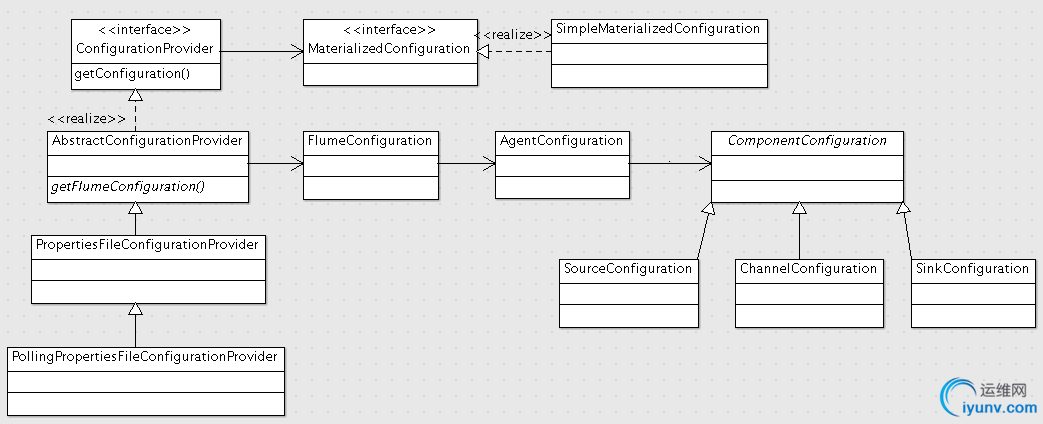|
|
日志收集是互联网公司的一个重要服务,Flume NG是Apache的顶级项目,是分布式日志收集服务的一个开源实现,具有良好的扩展性,与其他很多开源组件可以无缝集成。搜了一圈发现介绍Flume NG的文章有不少,但是深入分析Flume NG源代码的却没有。准备写一个系列分析一下Flume NG的源码。先从基础的配置模块说起。
Flume NG支持两种配置模式,一种是基于properties文件的静态配置,并且只加载一次。另一种是基于Guava EventBus发布订阅模式的动态配置,可运行时加载修改的配置。这篇先说说基于properties文件的静态配置。
下面这个是flume-conf.properties的一个常见配置
1. producers是agent的名字,一个agent表示一个Flume-NG的进程
2. producer.sources指定了这个agent监控的几个日志源,可以配置多个source
3. producer.channels, sinks指定了channel和sink,这些概念后面会说
4. producer.sources.sX.XXX指定了日志源获取的方式,对于从本地日志文件收集的方式来说,实际使用的是tail -F的命令来监控日志文件的尾部
producer.sources = s1 s2 s3
producer.channels = c
producer.sinks = r
producer.sources.s1.type = exec
producer.sources.s1.channels = c
producer.sources.s1.command = tail -F /data/logs/s1.log
producer.sources.s2.type = exec
producer.sources.s2.channels = c
producer.sources.s2.command = tail -F /data/logs/s2.log
producer.sources.s3.type = exec
producer.sources.s3.channels = c
producer.sources.s3.command = tail -F /data/logs/s3.log
producer.sinks.r.type = org.apache.flume.plugins.KafkaSink
producer.sinks.r.metadata.broker.list=server1:9092,server2:9092,server3:9092
producer.sinks.r.zk.connect=server1:2181,server2:2181,server3:2181,server4:2181,server5:2181
producer.sinks.r.partition.key=0
producer.sinks.r.partitioner.class=org.apache.flume.plugins.SinglePartition
producer.sinks.r.serializer.class=kafka.serializer.StringEncoder
producer.sinks.r.request.required.acks=0
producer.sinks.r.max.message.size=1000000
producer.sinks.r.producer.type=sync
producer.sinks.r.custom.encoding=UTF-8
producer.sinks.r.custom.topic.name=topic.xxx
#Specify the channel the sink should use
producer.sinks.r.channel = c
# Each channel's type is defined.
producer.channels.c.type = memory
producer.channels.c.capacity = 1000
再看看如何指定的producer这个agent名字以及指定采用哪个配置文件,下面是Flume NG的启动命令,-f指定了配置文件的路径,-n指定了agent的名字,也就是flume-conf.properties里面每项配置的前缀名
/flume-ng agent -c conf -f ../conf/flume-conf.properties -n producer -Dflume.root.logger=INFO,console > flume-ng.log 2>&1 &
来看看Flume-NG是如何来获取命令行参数,以及如何把flume-conf.properties的配置转化成它内部的数据结构的。
org.apache.flume.node.Application类是Flume NG的启动类,看一下它的main方法
1. 使用了commons-cli.jar提供的解析命令行参数的能力来解析命令行参数,把-n, -f/--conf-file, --no-reload-conf这几个配置信息读到变量
2. 打开由-f参数指定的配置文件,如果指定了no-reload-conf = false,也就是要运行时加载配置,就创建一个EventBus来发布和注册配置文件修改的事件,创建一个
PollingPropertiesFileConfigurationProvider 来轮询properties配置文件是否修改,如果修改就重新加载
3. no-reload-conf默认是true,也就是说默认是静态配置,只在启动时加载一次,只需要创建一个PropertiesFileConfigurationProvider来读取properties配置文件即可
public static void main(String[] args) {
try {
Options options = new Options();
Option option = new Option("n", "name", true, "the name of this agent");
option.setRequired(true);
options.addOption(option);
option = new Option("f", "conf-file", true, "specify a conf file");
option.setRequired(true);
options.addOption(option);
option = new Option(null, "no-reload-conf", false, "do not reload " +
"conf file if changed");
options.addOption(option);
option = new Option("h", "help", false, "display help text");
options.addOption(option);
CommandLineParser parser = new GnuParser();
CommandLine commandLine = parser.parse(options, args);
File configurationFile = new File(commandLine.getOptionValue('f'));
String agentName = commandLine.getOptionValue('n');
boolean reload = !commandLine.hasOption("no-reload-conf");
if (commandLine.hasOption('h')) {
new HelpFormatter().printHelp("flume-ng agent", options, true);
return;
}
/*
* The following is to ensure that by default the agent
* will fail on startup if the file does not exist.
*/
if (!configurationFile.exists()) {
// If command line invocation, then need to fail fast
if (System.getProperty(Constants.SYSPROP_CALLED_FROM_SERVICE) == null) {
String path = configurationFile.getPath();
try {
path = configurationFile.getCanonicalPath();
} catch (IOException ex) {
logger.error("Failed to read canonical path for file: " + path, ex);
}
throw new ParseException(
"The specified configuration file does not exist: " + path);
}
}
List<LifecycleAware> components = Lists.newArrayList();
Application application;
if(reload) {
EventBus eventBus = new EventBus(agentName + "-event-bus");
PollingPropertiesFileConfigurationProvider configurationProvider =
new PollingPropertiesFileConfigurationProvider(agentName,
configurationFile, eventBus, 30);
components.add(configurationProvider);
application = new Application(components);
eventBus.register(application);
} else {
PropertiesFileConfigurationProvider configurationProvider =
new PropertiesFileConfigurationProvider(agentName,
configurationFile);
application = new Application();
application.handleConfigurationEvent(configurationProvider.getConfiguration());
}
application.start();
final Application appReference = application;
Runtime.getRuntime().addShutdownHook(new Thread("agent-shutdown-hook") {
@Override
public void run() {
appReference.stop();
}
});
} catch (Exception e) {
logger.error("A fatal error occurred while running. Exception follows.",
e);
}
}
Flume NG配置相关的接口和类的结构如下
1. ConfigurationProvider顶层接口定义了 MaterializedConfiguration getConfiguration() 方法
2. MaterializedConfiguration接口表示具体化的配置,也就是把flume-conf.properties配置文件里定义的配置实例化成具体的对象。SimpleMaterializedConfiguration提供了实现,维护了实际运行时的配置数据结构
3. AbstractConfigurationProvider实现了ConfigurationProvider接口,并定义了abstract FlumeConfiguration getFlumeConfiguration()抽象方法
4. FlumeConfiguration, AgentConfiguration, SourceConfiguration, ChannelConfiguration, SinkConfiguration这几个类用来辅助解析flume-conf.properties配置文件,保存配置定义的字段
5. PropertiesFileConfigurationProvider从-f/--conf指定的配置文件中读取配置信息,只在读取一次
6. PollingPropertiesFileConfigurationProvider 采用轮询的方式从配置文件中读取配置信息,并支持动态修改配置

PropertiesFileConfigurationProvider的实现很简单
1. 首先是getFlumeConfiguration方法读取properties文件,然后转化成FlumeConfiguration结构的对象
2. 在 父类AbstractConfigurationProvider的getConfiguration方法生成MaterializedConfiguration实例,也就是创建实际运行时的Channel, SourceRunner, SinkRunner对象,它会从FlumeConfiguration中去读取各个对象的字段
public FlumeConfiguration getFlumeConfiguration() {
BufferedReader reader = null;
try {
reader = new BufferedReader(new FileReader(file));
Properties properties = new Properties();
properties.load(reader);
return new FlumeConfiguration(toMap(properties));
} catch (IOException ex) {
LOGGER.error("Unable to load file:" + file
+ " (I/O failure) - Exception follows.", ex);
} finally {
if (reader != null) {
try {
reader.close();
} catch (IOException ex) {
LOGGER.warn(
"Unable to close file reader for file: " + file, ex);
}
}
}
return new FlumeConfiguration(new HashMap<String, String>());
}
public MaterializedConfiguration getConfiguration() {
MaterializedConfiguration conf = new SimpleMaterializedConfiguration();
FlumeConfiguration fconfig = getFlumeConfiguration();
AgentConfiguration agentConf = fconfig.getConfigurationFor(getAgentName());
if (agentConf != null) {
Map<String, ChannelComponent> channelComponentMap = Maps.newHashMap();
Map<String, SourceRunner> sourceRunnerMap = Maps.newHashMap();
Map<String, SinkRunner> sinkRunnerMap = Maps.newHashMap();
try {
loadChannels(agentConf, channelComponentMap);
loadSources(agentConf, channelComponentMap, sourceRunnerMap);
loadSinks(agentConf, channelComponentMap, sinkRunnerMap);
Set<String> channelNames =
new HashSet<String>(channelComponentMap.keySet());
for(String channelName : channelNames) {
ChannelComponent channelComponent = channelComponentMap.
get(channelName);
if(channelComponent.components.isEmpty()) {
LOGGER.warn(String.format("Channel %s has no components connected" +
" and has been removed.", channelName));
channelComponentMap.remove(channelName);
Map<String, Channel> nameChannelMap = channelCache.
get(channelComponent.channel.getClass());
if(nameChannelMap != null) {
nameChannelMap.remove(channelName);
}
} else {
LOGGER.info(String.format("Channel %s connected to %s",
channelName, channelComponent.components.toString()));
conf.addChannel(channelName, channelComponent.channel);
}
}
for(Map.Entry<String, SourceRunner> entry : sourceRunnerMap.entrySet()) {
conf.addSourceRunner(entry.getKey(), entry.getValue());
}
for(Map.Entry<String, SinkRunner> entry : sinkRunnerMap.entrySet()) {
conf.addSinkRunner(entry.getKey(), entry.getValue());
}
} catch (InstantiationException ex) {
LOGGER.error("Failed to instantiate component", ex);
} finally {
channelComponentMap.clear();
sourceRunnerMap.clear();
sinkRunnerMap.clear();
}
} else {
LOGGER.warn("No configuration found for this host:{}", getAgentName());
}
return conf;
}
</pre><pre name="code" class="java"> |
|